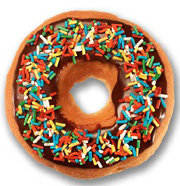 The question as to why doughnuts have holes has been raised by dozens of bakers over the years, but most agree that the answer to this sticky question lies in the fact that the interior of these fried cakes would not cook fully without a hole in the center. In short, the consistency of a doughnut lacking a hole would be, quite simply,
doughy. The question as to why doughnuts have holes has been raised by dozens of bakers over the years, but most agree that the answer to this sticky question lies in the fact that the interior of these fried cakes would not cook fully without a hole in the center. In short, the consistency of a doughnut lacking a hole would be, quite simply,
doughy.
Another
rivetingtheory as to the origin of the bulls eye in the doughnut holds that a sea captain named Hanson Gregory, while manning his post one stormy night, found it impossible both to steer his vessel and to eat his fried cake. Out of sheer frustration, and probably out of hunger, he
impaledhis cake over one of the
spokesof the ship's wheel, thereby creating a finger hold with which to grip the cake. Quite pleased with his
ingenuity, Mr. Gregory ordered the galley's cook to fry the cakes in that manner
henceforth.
Whatever the reason for the hole in the doughnut, this fried cake, with or without a hole, has been incorporated into the diets of people throughout the world for centuries. In fact,
archaeologistsfound
petrifiedfried cakes with holes amongst the
artifactsof a primitive Indian tribe.
Many credit Dutch settlers to America with introducing the non-holed olykoeks, or "oily cakes," to this continent, and with their subsequent popularity.
There is no disputing the fact that the fried cake became the rage in New York and in New England, and that before long, it became the specialty of coffee shops. Fried cakes came into their own in 1673, when a self-made New York marketing
guru, Anna Joralemon, made their purchase at the market possible.
To this day, doughnuts, in any shape or form, remain married in our minds to coffee and police officers, and are here to stay.
|
|
note:
|
doughy:半熟的
riveting:吸引人的
impale:刺穿
spoke:轮辐
ingenuity:独出心裁
henceforth:自此以后
archaeologist:考古学家
petrified:石化的
artifact:史前古器物
guru:权威人士
|
|
